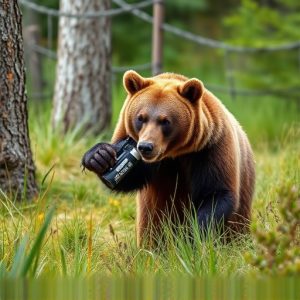Bear Spray Safety: Environmental Impact and Best Practices for Long-Term Protection
Bear spray, a popular safety measure in Alaska's wild areas, poses significant environmental ri…….
Bear spray, a popular safety measure in Alaska's wild areas, poses significant environmental risks due to its prolonged soil contamination. The active ingredients don't decompose readily and can persist, affecting local ecosystems and wildlife. Responsible application and disposal practices are crucial to balance personal safety and ecological preservation, considering the long-lasting impact of bear spray residue on soil and water. Implementing best practices, stringent regulations, education, and advanced technologies is essential to minimize these effects and ensure sustainable interactions between humans and wildlife in Alaska's pristine wilderness.
Alaska’s diverse landscapes are home to bears, making bear spray a common safety tool for outdoor enthusiasts. However, proper handling and disposal of this protective equipment are crucial to minimize environmental impact, especially regarding soil contamination. This article explores the duration of bear spray effectiveness and its potential persistence in the environment. We delve into the role of soil contamination, offering best practices and long-term solutions to prevent ecological damage while ensuring personal safety during encounters with Alaska’s bears.
- Understanding Bear Spray Safety and Its Impact on the Environment
- The Role of Soil Contamination in Bear Spray Use
- Duration of Bear Spray Effectiveness and Environmental Persistence
- Preventing Bear Spray Soil Contamination: Best Practices and Long-Term Solutions
Understanding Bear Spray Safety and Its Impact on the Environment
Bear spray is a popular tool for personal safety in areas inhabited by bears, but it’s crucial to understand its impact on the environment, especially when used in wild spaces like Alaska. When bear spray is deployed, it can create soil contamination that lingers for an extended duration, affecting not just the immediate area but also surrounding ecosystems. The active ingredients in bear spray, designed to deter and incapacitate bears, don’t readily decompose and can leach into the soil and water sources. This can have far-reaching consequences, impacting not only bear populations but also other wildlife and plants that depend on these habitats.
Moreover, improper use or disposal of bear spray can exacerbate soil contamination. It’s essential to follow guidelines for safe application and responsible disposal to minimize environmental harm. By understanding the potential ecological impact of bear spray, users can make informed decisions to balance personal safety with the preservation of Alaska’s unique and delicate natural landscape.
The Role of Soil Contamination in Bear Spray Use
Soil contamination plays a significant role in bear spray safety, especially when considering the long-term effects of its use. When bear spray comes into contact with the ground, it can potentially contaminate the soil, leading to harmful consequences for both the environment and future users. The duration of this impact is concerning; even a single application may leave residual chemicals that can persist for extended periods, depending on soil composition and local conditions.
This issue is particularly critical in remote areas where bear spray is frequently employed for protection against wild bears. Over time, repeated use could result in soil degradation and potential bioaccumulation of active ingredients, affecting not only the local ecosystem but also impacting future generations of plants and animals that rely on that habitat.
Duration of Bear Spray Effectiveness and Environmental Persistence
Bear spray is an effective deterrent against aggressive bears, but its effectiveness and environmental persistence are key factors to consider. The spray creates a barrier that can temporarily disable a bear, providing users with precious time to escape or defend themselves. However, the duration of its effectiveness varies based on several factors, including the type of spray, weather conditions, and environmental factors like soil contamination.
While bear spray is designed to break down over time, its residual effect on the environment can be significant. Soil contamination from the spray’s active ingredients may persist for extended periods, impacting local ecosystems and non-target species. Understanding these variables is crucial for responsible use and minimizing ecological disruption, especially in Alaska’s unique wilderness areas.
Preventing Bear Spray Soil Contamination: Best Practices and Long-Term Solutions
Preventing Bear Spray Soil Contamination requires a multi-faceted approach considering both immediate best practices and long-term solutions. When using bear spray, it’s crucial to avoid direct contact with the ground or plants to minimize soil contamination. This means deploying the spray at head height or higher, aiming away from vegetation, and ensuring proper disposal in designated waste containers.
For lasting impact, communities and individuals must advocate for stringent regulations and education programs that promote responsible bear spray usage. Long-term solutions involve investing in advanced containment technologies, such as specialized canisters designed to minimize environmental impact, and research into non-toxic deterrents. Additionally, fostering public awareness about the proper handling and disposal of bear spray is essential to preserving the ecological balance for both human and wildlife interactions in Alaska’s unique landscapes.
Bear spray is a valuable tool for personal safety in Alaska’s wild spaces, but its proper use and disposal are essential to mitigate environmental impact. Understanding the duration of bear spray effectiveness and the potential for soil contamination is crucial. By adopting best practices and long-term solutions, we can ensure that bear spray remains a safe and sustainable option for both individuals and ecosystems. Regularly updating our knowledge on these issues is vital in navigating and preserving Alaska’s unique landscape.


